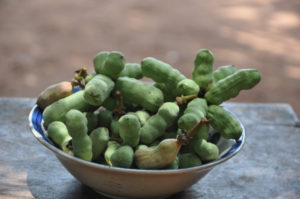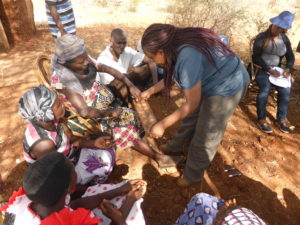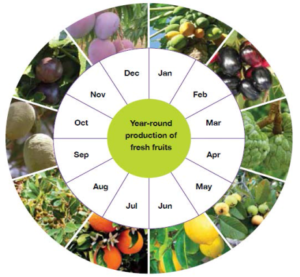
World Agroforestry’s (ICRAF) Food Tree and Crop Portfolio helps with the selection of food-tree species along with complementary vegetable, pulse and staple crops.
Foods from farms with trees — also known as agroforestry — are dense with nutrients. Fruits, vegetables, nuts, seeds and oils complement, and diversify, diets based on staple foods like rice, wheat and maize. This range of foods increases the nutritional quality of local diets, mostly owing to their micronutrients — mineral and vitamins — but also macronutrients, such as protein and carbohydrates.
Furthermore, these nutritional benefits can be available year-round and during periods of drought thanks to trees’ deep and extensive roots. Their roots make trees more resilient. This quality also helps tree foods bridge the ‘hunger gap’ that can occur before harvests of annual crops.
To fully harness the benefits of trees, ICRAF has developed an approach called the Food Tree and Crop Portfolio. The portfolio helps with the selection of socioecologically suitable and nutritionally important food-tree species along with complementary vegetable, pulse and staple crops.

The portfolios are a combination of indigenous and exotic species that are site-specific. Several aspects are assessed in each portfolio, such as diversity of on-farm food production, and food composition and consumption; the harvest months of prioritised food-tree and crop species are mapped against periods of food insecurity; and nutrient gaps can be filled by matching foods with nutrient-content data.
The successful adoption of a food-tree portfolio depends on several enabling and constraining factors that determine what farmers decide to plant and how the produce will be used. Farmers typically have a wealth of knowledge about food-tree species. They often prioritize their cultivation and use according to gender and age-related needs, interests and constraints that can sometimes be neglected in research-in-development projects.
Accordingly, central to the portfolio concept and its adoption into landscapes is understanding farmers’ preferences. Through the Agro-biodiversity and Landscape Restoration for Food Security and Nutrition in East Africa project, which is funded by the European Union and the International Fund for Agricultural Development, these have been carefully documented and used to inform portfolios in Ethiopia, Kenya and Uganda.
Particularly in the latter two countries, the project team has been able to better understand the availability of food trees as well as gendered and age-related priorities through the use of participatory-research methods.
A total of 57 food-tree species has been recorded: 47 in Uganda (including 58% exotic species) and 49 in Kenya (65% exotics). In both countries, knowledge of food-tree species differed by gender and age, with older women knowing the greatest number of species. In Uganda, the team found that older men preferred species used for timber and charcoal whereas women of all ages preferred species that were easily accessible and which played a role in providing children’s food. Both men and women valued food trees for their contribution to improved health and nutrition. But at all sites there was a preference for exotic species, such as mango (Mangifera indica), passion fruit (Passiflora edulis) and avocado (Persea americana).
Read also: Workshop on social and gender dynamics aims to improve resilience and livelihoods in Ghana

Younger women and men, in general, preferred species that were more marketable, although there were specific differences. Women in Kitui, Kenya, preferred species such as papaya (Carica papaya), chocolate berry (Vitex payos), guava (Psidium guajava) and tamarind (Tamarindus indica), which are sold in small quantities; men were not interested in them.
At both project sites in Kenya, women — especially older groups — preferred indigenous food trees more than men did, owing to their role in meeting household nutrition needs, especially as food for children, and for firewood and medicines. However, these species were reported to have poor markets.
The diversity of motivations and preferences are an indication of the complexities behind farmers’ decisions to plant certain trees and hint at the dynamic role played by intrahousehold decision-making in determining which preferences and needs are prioritized.
Previous studies in Kenya have shown that households often prioritized the sale of tree foods for income generation ahead of domestic consumption. The income earned from the sales was often spent on food, mostly less nutritious foods such as starchy staples. However, farmers usually expressed a desire to consume more fruit and, as was also found by the project team, they would like to plant more food trees.
When asked about the constraints to do so, farmers typically referred to a lack of seedlings — especially improved varieties — prolonged droughts and scarcity of land. Some of these constraints were gendered as well, with more younger women mentioning a lack of knowledge about planting and management as well as cultural restrictions, such as only having access to land when married; whereas younger men indicated the challenges of pests, limited markets, and land scarcity and ownership.
The project has also captured information on patterns of food consumption and the potential for marketing priority tree foods and crops. This information will link to the findings from gender-responsive, priority-setting activities to further explore the interactions between decision-making dynamics, food choices and food-tree and crop cultivation across farming landscapes in the region.
Based on the evidence generated by gender-sensitive, participatory research, the project team is developing site-specific interventions informed by local knowledge, preferences, needs and constraints to optimize the benefits of cultivating a diversity of food trees and crops to meet seasonal food needs, and enhance the availability of more nutritious foods.
Related reading:
- Encyclopaedia of food security and sustainability
- Delivering perennial new and orphan crops for resilient and nutritious farming systems
- Fruit production and consumption: practices, preferences and attitudes of women in rural Western Kenya
- Mainstreaming agrobiodiversity in sustainable food systems: scientific foundations for an agrobiodiversity index: summary
- Agroecology for food security and nutrition. Proceedings of the FAO International Symposium
- Understanding the roles of forests and tree-based systems in food provision
By Ana Maria Paez-Valencia, ICRAF social scientist.
Produced by World Agroforestry (ICRAF) as part of the CGIAR Research Program on Forests, Trees and Agroforestry (FTA). FTA is the world’s largest research for development program to enhance the role of forests, trees and agroforestry in sustainable development and food security and to address climate change. CIFOR leads FTA in partnership with Bioversity International, CATIE, CIRAD, INBAR, ICRAF and TBI. FTA’s work is supported by the CGIAR Trust Fund.











